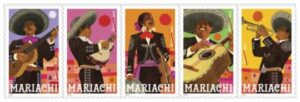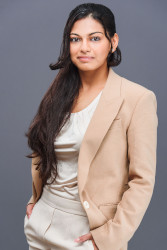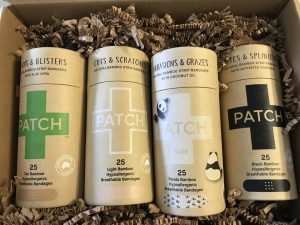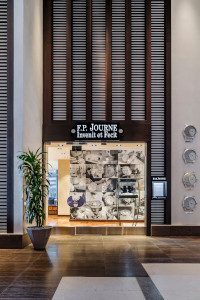Posted by Elena del Valle on October 5, 2022

Lindsay Walker, senior director of Development, Walter Cronkite School of Journalism and Mass Communication
Photo: Walter Cronkite School of Journalism and Mass Communication at Arizona State University
The Walter Cronkite School of Journalism and Mass Communication at Arizona State University pursuing its mission of “supporting communities of color, immigrants and LGBTQ+ individuals” is administering the Shaufler Prize in Journalism for its second year. According to a spokesperson who responded to questions via a public relations person via email, the contest “is open to all professional and student journalists, working at outlets of any size. We encourage entries in all formats, including video, audio, web and traditional print.”
Winners receive $20,000 in cash awards in the professional and student journalist categories. The first-place winner in the professional media category will receive $10,000. Second and third place winners will receive $3,000 and $2,000, respectively. The winner in the student category will receive a $5,000 award, according to a press release. In 2021, Paul B. Anderson, principal, of Seattle-based Workhouse Media, established the Shaufler Prize in Journalism in honor of his late friend, Ed Shaufler, who cared about promoting the understanding of underrepresented people, according to a press release.
“The Shaufler Prize, now in its second year, recognizes the best journalism in the country that advances the understanding of issues related to underserved people in society,” said Lindsay Walker, senior director of Development, Walter Cronkite School of Journalism and Mass Communication, when asked about the goal of the contest. “This prize seeks to recognize journalism that offers in-depth coverage of the issues affecting communities of color, immigrants and the LGBTQ+ population; tell stories that capture human experiences and build understanding among diverse people and communities; and explore and illuminate key public policy, legal, social, cultural or political issues regarding the treatment of marginalized communities and individuals.”
When asked how the organizers define “color” and underrepresented communities for purposes of submissions, she replied, “While we provide examples of such communities, we seek to allow journalists and their stories to illuminate the subjects and issues they are covering. In other words, the work can speak for itself, and we seek to be more inclusive — not less.”
The selection criteria? She said, “Judges evaluate the work based on four criteria: reporting quality, reporting depth, storytelling/narrative and impact potential.”
When asked how, if at all, the organizers distinguish between individual journalists and those working for large organizations and corporations she replied, “At this time, the contest does not make that distinction. Our aim is to let the work speak for itself.” When asked for the names, titles and affiliations of the judges who determine the winners and their photos she replied, “The judging panel for the 2022 contest is still being formed. The finalist judges in the professional category for 2021 included: Sharif Durhams Managing Editor of Raleigh News and Observer and Charlotte, Observer. (now with the Washington Post); Lee Edwards, digital based journalist with the Real Chi experimental newsroom in Chicago; Nora Lopez, managing editor of San Antonio Express, president of National Association of Hispanic Journalists in the country. She became a U.S citizen in 2008; and Asha Saluja, formerly audio producer and manager of Slate podcasts; former host on Radio Free Brooklyn.”
According to the press release, in its inaugural year, the 2021 first place prize was awarded to Toluse Olorunnipa and Griff Witte, and the staff of The Washington Post, for their story, Born with Two Strikes: How systemic racism shaped Floyd’s life and hobbled his ambition, part of the series, George Floyd’s America. Lizzie Presser of ProPublica took second place with Tethered to the Machine about JaMarcus Crews, who tried to get a new kidney. Maria Perez of the Milwaukee Journal Sentinel received third place for The Long Way Home about migrant workers at a Wisconsin green bean plant dying of COVID-19. In the student category, the Cronkite School’s Howard Center for Investigative Journalism took the top prize for Little Victims Everywhere, a series examining child sexual abuse in Indian Country.
Posted by Elena del Valle on July 20, 2022

New U.S.P.S. mariachi stamps
Photos: United States Postal Service
The United States Postal Service (U.S.P.S.) released a new stamp design of mariachis last week. It printed 18 million stamps, the usual average number for a stamp printing, according to a U.S.P.S. spokesperson. Rafael López, a Mexican illustrator who created official posters for the Obama campaign to target Latino voters, was contracted to do the artwork for the stamps.
When asked who selected the theme for the stamps Bill Gicker, director, Stamp Services, U.S.P.S. replied via an intermediary by email, “Subject matter for stamps is evaluated and selected by the Citizens’ Stamp Advisory Committee. The final decision for issuing a stamp resides with the Postmaster General of the United States.”
“Numbers are determined by like sales of past issuances,” he said. “Commemorative stamps are intended to be available for about a year.”

Rafael López designed the new stamps.
When asked what criteria was used to select the artist he replied, “The USPS works with contract art directors who determine the best way to portray particular subjects. They are always on the search new artists, designers and photographers. We have worked with Raphael in the past and the art directed felt his style and experience would be a good selection for this project.”
Regarding the budget for the project overall he said, “There are no specific budgets for stamp projects, but artists receive a standard $5,000 per design for each stamp design.”
“The USPS receives about 30,000 subject submissions per year, but does not accept art submissions,” he said when asked how many art submissions they receive a year.
According to his biography López was commissioned to create twelve United States Postal Stamps including the series of five Mariachi stamps featuring musicians dressed in the traje de charro, playing guitar, guitarrón, vihuela, violin and trumpet. According to his website the illustrator lives and works in San Diego and at his home studio in San Miguel de Allende, Mexico. The U.S.P.S. had worked with him in the past.
Posted by Elena del Valle on September 1, 2021

A lab grown 1.21 carat, D color, VVS2 Keystar Gems manufactured diamond
Photos: Keystar Gems
There may be good news for anyone in the market for discount lab grown diamonds. Wholesaler Keystar Gems has begun selling their products in the United States. The company buys lab diamond rough grown in China has it cut in Surat, India and sells it for one quarter less than the wholesale price of natural diamonds of similar cut, clarity and color, according to a company spokesperson. The company plans to attend a trade only wholesale event in Las Vegas, Nevada for the first time this year.
When asked about the company’s primary target audience Aagna S. Ajmera, chief marketing officer, Keystar Gems, said by email via a New York publicist, “Ultimately Keystar Gems would love for everyone to own lab-cultivated diamonds, but as far as the company’s direct clientele, Keystar Gems is B2B, selling within the trade to jewelry design ateliers, large retailers, distributors, dealers, and to other lab-grown manufacturers.”

Aagna S. Ajmera, chief marketing officer, Keystar Gems
“On average it takes about 7-10 business days to go from rough to polish during the manufacturing process, which is very fast within the gem trade, and differentiates Keystar Gems from other lab grown manufacturers,” Ajmera said when asked what differentiates Keystar Gems from other lab grown diamond sellers. “This is entirely due to the expertise of Maheshbhai Radadiya, the Founder of Keystar Gems, who still personally studies every new rough diamond, along with the handling team, which has been trained by him. Keystar Gems is also known for having exceptional cutting, polish and symmetry, another distinguishing factor.”
“The colored diamonds are all custom orders,” said Ajmera when asked about color diamonds. “For Keystar Gems, the majority of the demand is for white diamonds.
An additional color treatment is required for most desired colors. Blue diamonds, however, don’t require a treatment. Colored diamonds need to be processed, so it isn’t more difficult to make them per say, it just takes more time to make a colored diamond.”
According to promotional materials provided by the company’s public relations agency, Keystar Gems is producing over 10,000 carats of High-Pressure High-Temperature (HPHT) lab grown diamonds a month. The diamonds range from 0.03 to 10 carats in size and are available in a variety of shapes and clarities. The company manufactures white, pink, blue and yellow manmade diamonds.
Although natural diamonds can take millions to billions of years to form, an HPHT diamond can be grown in under a week, according to information the agency provided. A company representative explained that “this kind of quantity is seen with Chemical Vapour Deposition (CVD) diamonds, but has not been seen before with HPHT.” The Surat-based company is owned by Radadiya, founder, and Shivang S. Rao, cofounder and director.
Posted by Elena del Valle on July 27, 2021

Latest OECD employment and unemployment numbers – click to enlarge
Graphic: OECD
According to an embargoed press release from the Organisation for Economic Co-operation and Development (OECD), the OECD area employment rate rose to 66.8 percent in the first quarter of 2021 from 66.7 percent in the previous quarter; wide disparities across countries are visible. The organization defined OECD area employment rate as the share of the working-age population with jobs.
In the first quarter of this year in the United States employment was 68.4 percent compared to 66.9 percent in the euro area, and 77.6 percent in Japan. It is notable that the Netherlands had a 79.3 percent employment rate, the highest in the region, and Greece 59.9 percent, the region’s minimum.
The press release clarified the following: Methodological changes to the European Union (E.U.) Labour Force Survey blur the comparison between the fourth quarter of 2020 and the first quarter of 2021 for EU countries. In addition, a large part of the increase in the third and, to a lesser extent, fourth quarter of 2020 reflects the return to work of furloughed workers in Canada and the United States, where they are recorded as unemployed, whereas in most other countries, they are recorded as employed.
Working with over 100 countries, the OECD is “a global policy forum that promotes policies to preserve individual liberty and improve the economic and social well-being of people around the world.”
Posted by Elena del Valle on July 27, 2020
Your payment has been made and the transaction completed.
Please submit your job ad materials as described on the job ads page.
PayPal should send you details for your payment transaction. Log into your paypal account to view transaction details.
Posted by Elena del Valle on March 11, 2020

Patch adhesive strips
Photo: HispanicMPR.com
Nutricare, an Australian company, released Patch, a line adhesive strips described as 100 percent compostable and hypoallergenic. Made somewhere in China (Guangzhou, China is listed on the package) from bamboo fiber the strips are free of plastics, latex, silicone, and harmful toxins, according to promotional materials. They are designed for easy pain-free removal with sensitive skin and aged skin in mind. Each package of 25 strips retails for just under $9 and has an expiration date. The sample packages we received expire June 2021.
“The bandages and all packaging breaks down into soil in just a matter of weeks,” according to a company press release. Four product lines are available Patch Natural, Patch Coconut Oil Kids for abrasions and grazes, Patch Aloe Vera for burns and blisters, and Patch Activated Charcoal for bites and splinters.
In the United States, the products are for sale on the company website, Amazon, Grove Collaborative, Anthropologie and CVS as well as select grocery stores and specialized retailers. The Patch website indicates the company uses a Lyocell production process (a cellulose fabric made by an organic solvent spinning process), “considered to be the most environmentally friendly method of manufacturing bamboo cloth fibre. This is because it is more sustainable than most common chemical processing methods.”
According to the product website, the brand uses “specially curated pressure sensitive adhesive (PSA) formulation, made from a combination of minerals and applied with nano technology process (think tiny suction cups)” to adhere to the skin. According to a press release Nutricare is an “environmentally conscious and solutions-focused brand” working to create natural solutions to common health care items.
Posted by Elena del Valle on January 2, 2020

Posted by Elena del Valle on March 20, 2019

Although the space is called Maison F.P. Journe the sign above the store reads F.P. Journe Invenit et fecit.
Photos: Kris Tamburello
Last month Francois Paul Journe and Pierre Halimi Lacharlotte opened Maison F.P. Journe, a watch boutique offering upscale liquor and Petrossian snacks, in
Miami (270 Biscayne Boulevard Way, Suite 101, Miami, Florida 33131, 305-993-4747, miami@fpjourne.com). The 3,200 square foot space will sell 15 Swiss watch models in different iterations. The shop has seating capacity for 42. It includes 10 bar seats and two lounges inside the boutique, as well as seating for 20 on the outside Terraza Astondoa, a cigar lounge. The exterior sign of the store reads: F.P. Journe Invenit et fecit. The last three words, according to a spokesperson, translate to “invented and made” from Latin, and is meant to certify that “each of the watches carrying FPJ’s name results from an entirely original conception with rigorous craftsmanship.”

The shop has seating capacity for 42.
The owners expect the shop to attract affluent people in Miami, liquor connoisseurs, watch aficionados, caviar fans and “anyone who enjoys an elevated bar and retail experience.” The space includes Bar Journe, an upscale bar that serves curated bites, Petrossian caviar and rare liquors. The outdoor lounge area outfitted by Spanish yacht-maker Astondoa is described as offering stunning views of Miami and cigars by La Flor Dominicana.

François-Paul Journe, co-owner, Maison F.P. Journe
A “fine and rare” collection includes about 24 antique and aged items. Watch prices range from $11,000 for the Electro Mechanical Elegante in 40 millimeters for ladies or men to 711,000 Swiss francs. Prices are offered in Swiss francs “because the price in USD is given at the time of purchase to accurately reflect the conversion,” according to a company spokesperson. One watch, the Tourbillon on a baguette set platinum case and bracelet, sells for $939,900.
Sample prices for liquor, spirits and wine include $8 for a beer, $55 for a 2 ounce serving of 1942 Don Julio Añejo on the rocks and $385 for a bottle of Cabernet Sauvignon. The caviar is from different farms around the world and prices range from $98 to $990. The shop sells three types of caviar, Royal Shassetra, Alberta President and Ossetra President, at 30 grams or 125 grams accompanied by yuca chips. There is also a suggested pairings for each caviar and a tasting menu priced at $485.
Posted by Elena del Valle on January 2, 2019

Best wishes for a healthy, happy and prosperous new year.
Posted by Elena del Valle on July 12, 2018

Monica Escaleras, Ph.D., director, FAU BEPI
Photo: College of Business at Florida Atlantic University
Researchers at Florida Atlantic University (FAU) believe Hispanic consumer confidence stalled in the second quarter of 2018 compared to the first quarter of the year. They drew their conclusions from a new national consumer sentiment index conducted by the Florida Atlantic University Business and Economics Polling Initiative (FAU BEPI) in FAU’s College of Business. The conclusions were derived from a recorded survey online and by landline of 850 Hispanics 18 years or older.
“Hispanics are less optimistic of their financial situation and the short-term economic outlook of the country,” said Monica Escaleras, Ph.D., director, FAU BEPI. “They’re concerned about what they perceive as a rising cost of living, gas prices and interest rates. All of this leads Hispanics to be less eager to consume more.”
The second quarter Hispanic Consumer Sentiment Index (HCSI) dropped from 98.9 in the first quarter to an 86.4 in the second quarter, according to the 11-page report titled Hispanics Consumer Confidence Stall in Second Quarter of 2018 Cost of Living on the Rise and Less Likelihood to Buy a House or Car. Information provided by the university indicates that the HCSI continues to trail the general population score of 98.2 as published by the University of Michigan in June 2018.
When asked by email how researchers identify respondents Escaleras said, “Respondents self-identify as Hispanics. Specifically, this is the question that we ask: Are you of Hispanic, Latino or Spanish origin? If the answer is yes, then they take the survey. If the answer is no, then the survey ends.”
The poll, available to respondents in English and Spanish, was funded by the Dean’s Office in College of Business at Florida Atlantic University, according Escaleras, who declined to disclose the budget for the project.
“We use two modes of data collection: online and landlines,” she said. “The online sample is supplied by Survey Sampling International. For the landlines, the Hispanic phone lists are supplied by Aristole, Inc and then the questions are recorded in both languages English and Spanish. Finally, the we use a computer software call Stratics to randomly pick phone numbers and call. The calls are automated and the questions are pre-recorded or what is call robocalling. IVR stands for Interactive Voice Response which is a technology that allows respondents to interact with surveyor (which pre-recorded the questions) via a telephone keypad or by speech recognition.”
Hispanics’ short-run economic outlook for the country dipped, with only 50 percent saying they expect the country as a whole to experience good business conditions in the upcoming year, down 11 points compared to the first quarter. Among survey takers 52 percent said they think it is good time to buy big-ticket items, compared to 69 percent in the first quarter.
Four out of five poll takers said the cost of living has gone up, a 21 percent rise since the first quarter. Per the press release, this perception, along with increasing concerns over their level of debt, rising gas prices and interest rate hikes, may explain why only 51 percent said they think it is a good time to buy a house (down from 59 percent in the first quarter), and only 49 percent said it is a good time to buy a car (down from 62 percent).
Sixty-eight percent of respondents said they were born in the United States; 65.5 percent self-identified as Mexican, Mexican-American or Chicano; 50.5 percent were men; 36.5 percent said they were employed full-time; 64 percent said they owned their home; and 42.5 percent were between 18 and 34 years of age.
According to a press release, the Florida Atlantic University Business and Economic Polling Initiative conducts surveys on business, economic, political and social issues with a focus on Hispanic attitudes and opinions at regional, state and national levels via planned monthly national surveys. Florida Atlantic University, established in 1961, officially opened its doors in 1964 as the fifth public university in Florida. The same release indicates the University serves more than 30,000 undergraduate and graduate students through 10 colleges at sites throughout its six-county service region in southeast Florida.






















